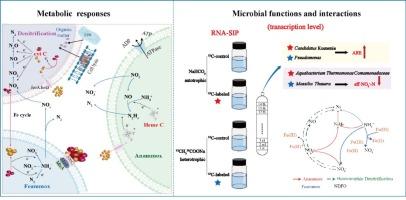亚硝酸根限制下提高厌氧氨氧化脱氮性能:Fe2O3投加方式的影响及其机制
IF 13.2
1区 工程技术
Q1 ENGINEERING, CHEMICAL
引用次数: 0
摘要
作为一种节能、可持续的脱氮方法,NO2−-N的稳定获取是制约厌氧氨氧化应用的瓶颈。为了解决这一限制,本研究研究了Fe2O3作为NH4+-N氧化的潜在电子受体,研究了它的添加模式和脱氮的潜在机制。Fe2O3的短期脉冲剂量(10-250 mg/L)可以维持氮的去除,而缺乏或过量(500 mg/L)由于Fe2O3对NO2−-N的限制和微生物的抑制而降低了效率。通过促进Fe(III)还原耦合厌氧铵氧化(Feammox)和NOx依赖的Fe(II)氧化(NDFO)过程,长期增加Fe2O3添加可提高NH4+-N和总氮去除效率。Fe2O3的加入提高了电子传递系统的活性,细胞内Fe(II)介导了关键电子传递和能量代谢过程。Fe2O3的加入增加了与基因表达调控和跨膜运输相关的功能基因的丰度,增强了参与氮转化和碳代谢的基因的转录活性。此外,Fe2O3促进胞外聚合物质的分泌和微生物裂解,支持异养细菌的生长。RNA稳定同位素示踪鉴定出自养型Kuenenia和异养型假单胞菌是去除NH4+-N的关键微生物。同时,自养型和异养型反硝化菌也导致出水NO3−-N的逐渐减少。该研究深入了解了Fe2O3对氮去除的影响,并为解决厌氧氨氧化反应中NO2−-N限制导致的性能下降提供了有效的策略。本文章由计算机程序翻译,如有差异,请以英文原文为准。

Enhancing nitrogen removal performance under Anammox subjected to nitrite limitation: The impact of Fe2O3 dosing modes and underlying mechanisms
As an energy-saving and sustainable method for nitrogen removal, the stable acquisition of NO2−-N is a bottleneck for the application of Anammox. To address this limitation, this study investigated Fe2O3 as a potential electron acceptor for NH4+-N oxidation, examining its addition modes and underlying mechanisms for nitrogen removal. Short-term pulse dosing of Fe2O3 (10–250 mg/L) sustained nitrogen removal, whereas absence or excess (500 mg/L) impaired efficiency due to NO2−-N limitation and microbial inhibition by Fe2O3. Long-term incremental Fe2O3 addition enhanced NH4+-N and total nitrogen removal efficiencies by facilitating Fe(III) reduction coupled to anaerobic ammonium oxidation (Feammox) and NOx−-dependent Fe(II) oxidation (NDFO) processes. Fe2O3 addition improved the activity of electron transfer system, with intracellular Fe(II)-mediated key electron transfer and energy metabolism processes. The abundance of functional genes associated with gene expression regulation and transmembrane transport was increased by Fe2O3 addition, enhancing the transcriptional activity of genes involved in nitrogen transformation and carbon metabolism. Furthermore, Fe2O3 promoted the secretion of extracellular polymeric substances and microbial lysis, supporting the growth of heterotrophic bacteria. RNA stable isotope tracing identified autotrophic Candidatus Kuenenia and heterotrophic Pseudomonas as key microorganisms in NH4+-N removal. Concurrently, autotrophic and heterotrophic denitrifiers contributed to a progressive decrease in effluent NO3−-N. This study provides an in-depth understanding of the impact of Fe2O3 on nitrogen removal and offers an effective strategy to solve performance decline associated with NO2−-N limitations for Anammox.
求助全文
通过发布文献求助,成功后即可免费获取论文全文。
去求助
来源期刊

Chemical Engineering Journal
工程技术-工程:化工
CiteScore
21.70
自引率
9.30%
发文量
6781
审稿时长
2.4 months
期刊介绍:
The Chemical Engineering Journal is an international research journal that invites contributions of original and novel fundamental research. It aims to provide an international platform for presenting original fundamental research, interpretative reviews, and discussions on new developments in chemical engineering. The journal welcomes papers that describe novel theory and its practical application, as well as those that demonstrate the transfer of techniques from other disciplines. It also welcomes reports on carefully conducted experimental work that is soundly interpreted. The main focus of the journal is on original and rigorous research results that have broad significance. The Catalysis section within the Chemical Engineering Journal focuses specifically on Experimental and Theoretical studies in the fields of heterogeneous catalysis, molecular catalysis, and biocatalysis. These studies have industrial impact on various sectors such as chemicals, energy, materials, foods, healthcare, and environmental protection.
 求助内容:
求助内容: 应助结果提醒方式:
应助结果提醒方式:


